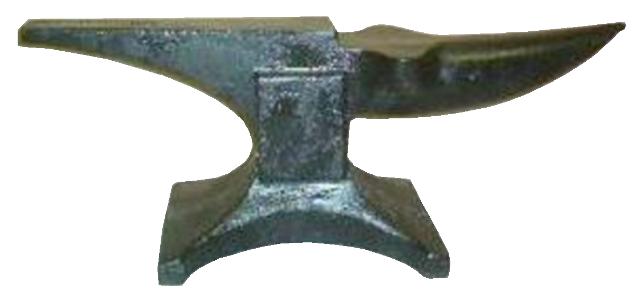TOP: An unidentified (possibly an NC) farrier's anvil.
BOTTOM: Oklahoma Horse Shoeing School Anvil with Oklahoma state map logo.
Farriers' anvils such as these have been made since the 1960's.
They are light, thus portable and have very large work surfaces for their weight.
The horns are flattened and oval in section with "clip horns" on the side for forging toe caulks on shoes.
Weights range from 65 tp 130 pounds (30 to 60 kgs).
Later farrier anvils have notched heels to make "turning cams" of they protrude from one side.
Some have grooves for punching. Some are hollow.
Some have large round hardy holes to make it easier to bend shoes.
These require special round shank hardies.
Farriers' anvils are not suitable for heavy shop use.
They are springy and inefficient. Forge work takes more effort.
These anvils are designed to be portable and for a single purpose.
Due to the cold work abuse that these anvils recieve Bill Pieh of Centaur Forge used to say that farrier's anvils were a consumable product.
This may be true but I have always suspected that the trendyness of new features on these anvils is another reason for replacing them often.

American Style Farrier's Anvil
Possibly a "Big Tex" from the 1960's. The art of the anvil.

Boxed Farrier Anvil Pattern
Mold box mounted pattern seen at SOFA QuadState in 2005.
Includes definitions of foundry pattern types.
 Queen City Steel Farriers' Anvil
Queen City Steel Farriers' Anvil
Rare anvil made by Kohlswa contracted through Centaur Forge.






BOTTOM: Oklahoma Horse Shoeing School Anvil with Oklahoma state map logo.
Farriers' anvils such as these have been made since the 1960's. They are light, thus portable and have very large work surfaces for their weight. The horns are flattened and oval in section with "clip horns" on the side for forging toe caulks on shoes. Weights range from 65 tp 130 pounds (30 to 60 kgs).
Later farrier anvils have notched heels to make "turning cams" of they protrude from one side. Some have grooves for punching. Some are hollow. Some have large round hardy holes to make it easier to bend shoes. These require special round shank hardies.
Farriers' anvils are not suitable for heavy shop use. They are springy and inefficient. Forge work takes more effort. These anvils are designed to be portable and for a single purpose.
Due to the cold work abuse that these anvils recieve Bill Pieh of Centaur Forge used to say that farrier's anvils were a consumable product. This may be true but I have always suspected that the trendyness of new features on these anvils is another reason for replacing them often.
American Style Farrier's Anvil
Possibly a "Big Tex" from the 1960's. The art of the anvil.
Boxed Farrier Anvil Pattern
Mold box mounted pattern seen at SOFA QuadState in 2005.
Includes definitions of foundry pattern types.
Rare anvil made by Kohlswa contracted through Centaur Forge.